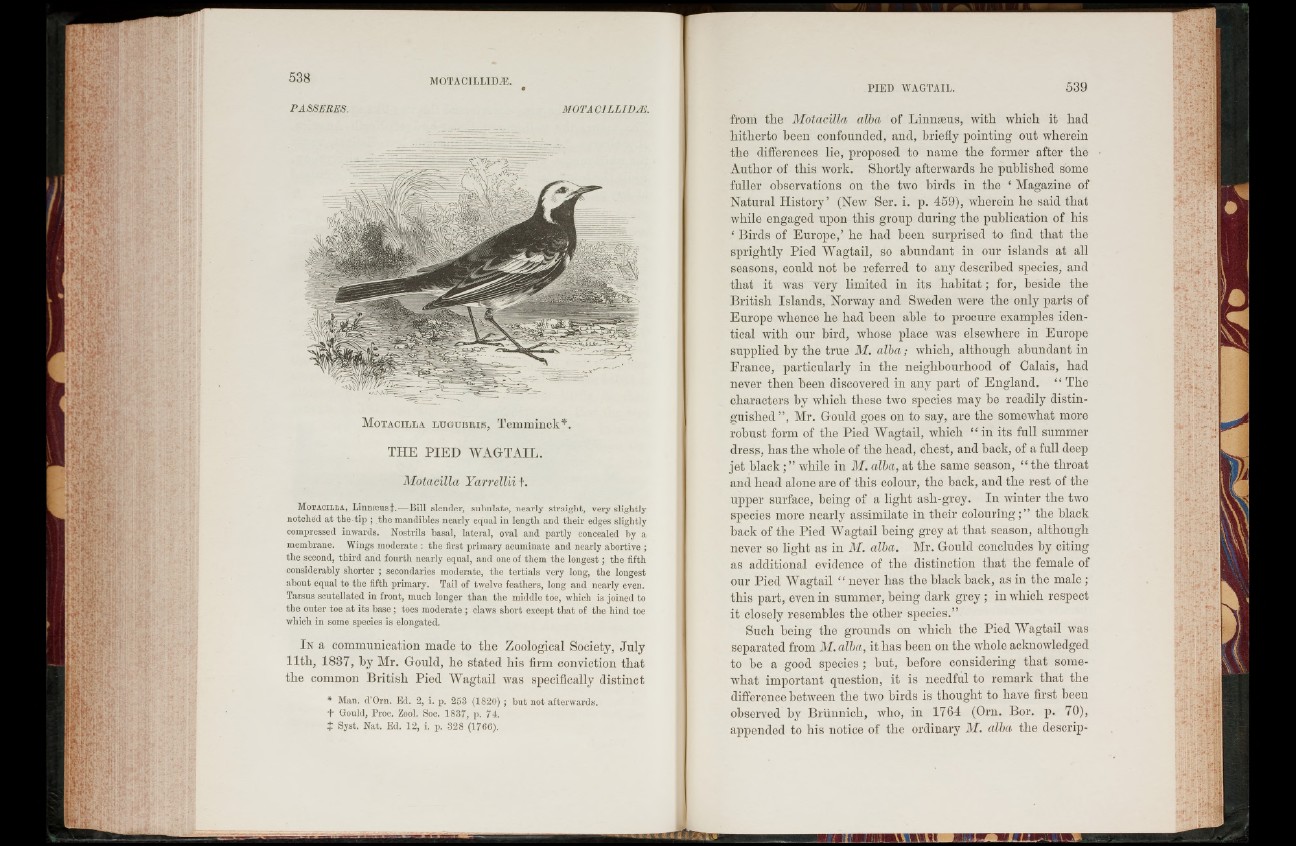
M o ta c il la l u g u b r is , Temminck*.
THE PIED WAGTAIL.
Motacilla Yarrellii t.
M otac il la , Linnaeus f .—Bill slender, subulate, nearly straight, very slightly
notched at the tip ; the mandibles nearly equal in length and their edges slightly
compressed inwards. Nostrils basal, lateral, oval and partly concealed by a
membrane. Wings moderate : the first primary acuminate and nearly abortive ;
the second, third and fourth nearly equal, and one of them the longest ; the fifth
considerably shorter ; secondaries moderate, the tertials very long, the longest
about equal to the fifth primary. Tail of twelve feathers, long and nearly even.
Tarsus scutellated in front, much longer than the middle toe, which is joined to
the outer toe at its base ; toes moderate ; claws short except that of the hind toe
which in some species is elongated.
I n a communication macle to tlie Zoological Society, July
11th, 1837, by Mr. Gould, he stated his firm conviction that
the common British Pied Wagtail was specifically distinct
* Man. d’Orn. Ed. 2, i. p. 253 (1820); but not afterwards.
+ Gould, Proe. Zool. Soc. 1837, p. 74.
t Syst. Nat. Ed. 12, i. p. 328 (1766).
from the Motacilla alba of Linnaeus, with which it had
hitherto been confounded, and, briefly pointing out wherein
the differences lie, proposed to name the former after the
Author of this work. Shortly afterwards he published some
fuller observations on the two birds in the ‘ Magazine of
Natural History’ (New Ser. i. p. 459), wherein he said that
while engaged upon this group during the publication of his
‘ Birds of Europe,’ he had been surprised to find that the
sprightly Pied Wagtail, so abundant in our islands at all
seasons, could not be referred to any described species, and
that it was very limited in its h ab ita t; for, beside the
British Islands, Norway and Sweden were the only parts of
Europe whence he had been able to procure examples identical
with our bird, whose place was elsewhere in Europe
supplied by the true M. alba; which, although abundant in
France, particularly in the neighbourhood of Calais, had
never then been discovered in any part of England. “ The
characters by which these two species may be readily distinguished
”, Mr. Gould goes on to say, are the somewhat more
robust form of the Pied Wagtail, which “ in its full summer
dress, has the whole of the head, chest, and back, of a full deep
jet black; ” while in M. alba, at the same season, “ the throat
and head alone are of this colour, the back, and the rest of the
upper surface, being of a light ash-grey. In winter the two
species more nearly assimilate in their colouring;” the black
back of the Pied Wagtail being grey at that season, although
never so light as in M. alba. Mr. Gould concludes by citing
as additional evidence of the distinction that the female of
our Pied Wagtail “ never has the black back, as in the male;
this part, even in summer, being dark grey ; in which respect
it closely resembles the other species.”
Such being the grounds on which the Pied Wagtail was
separated from M. alba, it has been on the whole acknowledged
to be a good species; but, before considering that somewhat
important question, it is needful to remark that the
difference between the two birds is thought to have first been
observed by Briiunich, who, in 1764 (Orn. Bor. p. 70),
appended to his notice of the ordinary M. alba the descrip